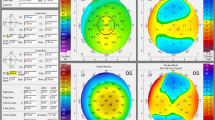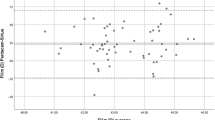Abstract
To evaluate Pentacam-Scheimpflug imaging of anterior segment parameters in young Indian adults. In this prospective study 120 eyes of 60 normal Indian subjects with a mean age of 25.93 ± 6.58 years (range 17–39 years) were assessed by Pentacam. Main outcome measures were central corneal thickness (CCT), thinnest corneal thickness (TCT), apex corneal thickness (apex CT), peripheral corneal thickness at 2, 4, 6 and 8 mm from the thinnest point, location of the thinnest pachymetry, corneal volume (CV), anterior chamber depth (ACD), anterior chamber volume (ACV) and anterior chamber angle (ACA). Independent samples t test, dependent samples t test, ANOVA and Pearson correlation test were used for statistical analysis. The mean CCT, TCT, Apex CT and CV were 544.95 ± 35.42, 542 ± 35.19, 545.43 ± 35.45 and 61.64 ± 4.17 μm, respectively. There was a gradual increase in CT from the thinnest point to the periphery. The mean ACD was 3.14 ± 0.33 mm, mean ACV was 177.77 ± 29.02 mm3, and mean ACA was 39.36° ± 5.42°. There was no significant difference between CCT, TCT and Apex CT. A significant positive correlation was found between CCT and peripheral CT and also between anterior chamber parameters. TCT was mainly located in the inferotemporal and superotemporal zone. No significant difference was found in parameters between the right and left eyes and also between genders. This study provided information about a wide range of parameters in the anterior segment of healthy Indian eyes. These results could be helpful in assessment of patients with corneal diseases, glaucoma and screening for refractive surgeries.



Similar content being viewed by others
References
Binder PS, Lindstrom RL, Stulting RD, Donnenfeld E, Wu H, McDonnell P, Rabinowitz Y (2005) Keratoconus and corneal ectasia after LASIK. J Refract Surg 21(6):749
Ahmadi Hosseini S, Mohidin N, Abolbashari F, Mohd-Ali B, Santhirathelagan C (2012) Corneal thickness and volume in subclinical and clinical keratoconus. Int Ophthalmol pp 1–7. doi:10.1007/s10792-012-9654-x
Brandt JD (2004) Corneal thickness in glaucoma screening, diagnosis, and management. Curr Opin Ophthalmol 15(2):85
Holden BA, Sweeney DF, Vannas A, Nilsson KT, Efron N (1985) Effects of long-term extended contact lens wear on the human cornea. Invest Ophthalmol Vis Sci 26(11):1489
Abolbashari F, Mohidin N, Ahmadi Hosseini SM, Retnasabapathy S (2013) Anterior segment characteristics of keratoconus eyes in a sample of Asian population. Contact Lens Anter Eye pp 1–5. doi:10.1016/j.clae.2013.01.005
Lee Y, Sung KR, Na JH, Sun JH (2012) Dynamic changes in anterior segment (AS) parameters in eyes with primary angle closure (PAC) and PAC glaucoma and open-angle eyes assessed using AS optical coherence tomography. Invest Ophthalmol Vis Sci 53(2):693–697
Németh J, Fekete O, Pesztenlehrer N (2003) Optical and ultrasound measurement of axial length and anterior chamber depth for intraocular lens power calculation. J Cataract Refract Surg 29(1):85–88
Malyugin BE, Shpak AA, Pokrovskiy DF (2012) Accommodative changes in anterior chamber depth in patients with high myopia. J Cataract Refract Surg 38(8):1403–1407
Aghaian E, Choe JE, Lin S, Stamper RL (2004) Central corneal thickness of Caucasians, Chinese, Hispanics, Filipinos, African Americans, and Japanese in a glaucoma clinic. Ophthalmology 111(12):2211–2219
Casson RJ (2008) Anterior chamber depth and primary angle-closure glaucoma: an evolutionary perspective. Clin Exp Ophthalmol 36(1):70–77
Leung C, Palmiero P, Weinreb R, Li H, Sbeity Z, Dorairaj S, Leung D, Liu S, Liebmann J, Congdon N (2010) Comparisons of anterior segment biometry between Chinese and Caucasians using anterior segment optical coherence tomography. Br J Ophthalmol 94(9):1184–1189
Cheng C-Y, Aung T, Zheng Y, Li X, Anuar AR, Chew M, Mani B, Saw S-M, Wong TY, SEED Study Group (2012) Intraocular Pressure and Central Corneal Thickness in a Multi-Ethnic Asian Population: The Singapore Epidemiology of Eye Disease (SEED) Study. Invest Ophthalmol Vis Sci 53 (6): E-Abstract 6376
Cho P, Lam C (1999) Factors affecting the central corneal thickness of Hong Kong-Chinese. Curr Eye Res 18(5):368–374
Doughty MJ, Zaman ML (2000) Human corneal thickness and its impact on intraocular pressure measures* 1,* 2: a review and meta-analysis approach. Surv Ophthalmol 44(5):367–408
Doughty MJ, Fonn D, Richter D, Simpson T, Caffery B, Gordon K (1997) A patient questionnaire approach to estimating the prevalence of dry eye symptoms in patients presenting to optometric practices across Canada. Optom Vis Sci 74(8):624
Fares U, Otri AM, Al-Aqaba MA, Dua HS (2012) Correlation of central and peripheral corneal thickness in healthy corneas. Cont Lens Anterior Eye 35(1):39–45
Emre S, Doganay S, Yologlu S (2007) Evaluation of anterior segment parameters in keratoconic eyes measured with the Pentacam system. J Cataract Refract Surg 33(10):1708–1712
Ashwin PT, Shah S, Pushpoth S, Wehbeh L, Ilango B (2009) The relationship of central corneal thickness (CCT) to thinnest central cornea (TCC) in healthy adults. Cont Lens Anterior Eye 32(2):64–67
Khoramnia R, Rabsilber TM, Auffarth GU (2007) Central and peripheral pachymetry measurements according to age using the Pentacam rotating Scheimpflug camera. J Cataract Refract Surg 33(5):830–836
Xu L, Cao WF, Wang YX, Chen CX, Jonas JB (2008) Anterior chamber depth and chamber angle and their associations with ocular and general parameters: the Beijing Eye Study. Am J Ophthalmol 145(5):929
Wu RY, Nongpiur ME, He MG, Sakata LM, Friedman DS, Chan YH, Lavanya R, Wong TY, Aung T (2011) Association of narrow angles with anterior chamber area and volume measured with anterior-segment optical coherence tomography. Arch Ophthalmol 129(5):569
Rabsilber TM, Khoramnia R, Auffarth GU (2006) Anterior chamber measurements using Pentacam rotating Scheimpflug camera. J Cataract Refract Surg 32(3):456–459
Quigley HA, Congdon NG, Friedman DS (2001) Glaucoma in China (and worldwide): changes in established thinking will decrease preventable blindness. Brit J Ophthalmol 85(11):1271–1272
Lavanya R, Foster PJ, Sakata LM, Friedman DS, Kashiwagi K, Wong TY, Aung HT, Alfred T, Gao H, Ee AG (2008) Screening for narrow angles in the Singapore population: evaluation of new noncontact screening methods. Ophthalmology 115 (10):1720–1727. e1722
Kurita N, Mayama C, Tomidokoro A, Aihara M, Araie M (2009) Potential of the pentacam in screening for primary angle closure and primary angle closure suspect. J Glaucoma 18(7):506
Wang D, Qi M, He M, Wu L, Lin S (2012) Ethnic difference of the anterior chamber area and volume and its association with angle width. Invest Ophthalmol Vis Sci 53(6):3139–3144
Acknowledgments
The article has not been presented in a meeting. The authors did not receive any financial support from any public or private sources. The authors have no financial or proprietary interest in a product, method, or material described here.
Author information
Authors and Affiliations
Corresponding author
Rights and permissions
About this article
Cite this article
Ahmadi Hosseini, S.M., Abolbashari, F. & Mohidin, N. Anterior segment parameters in Indian young adults using the Pentacam. Int Ophthalmol 33, 621–626 (2013). https://doi.org/10.1007/s10792-013-9747-1
Received:
Accepted:
Published:
Issue Date:
DOI: https://doi.org/10.1007/s10792-013-9747-1




